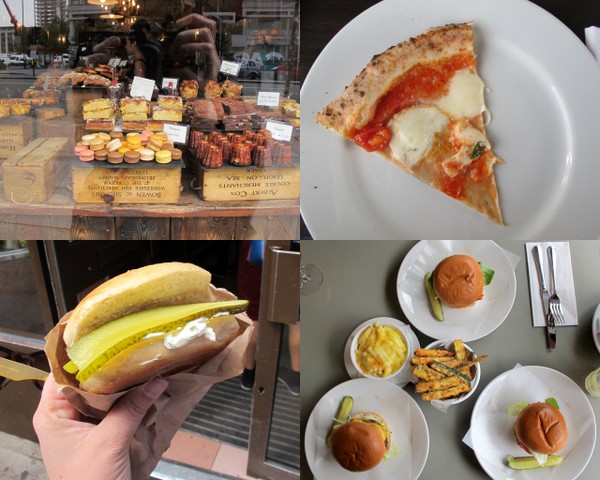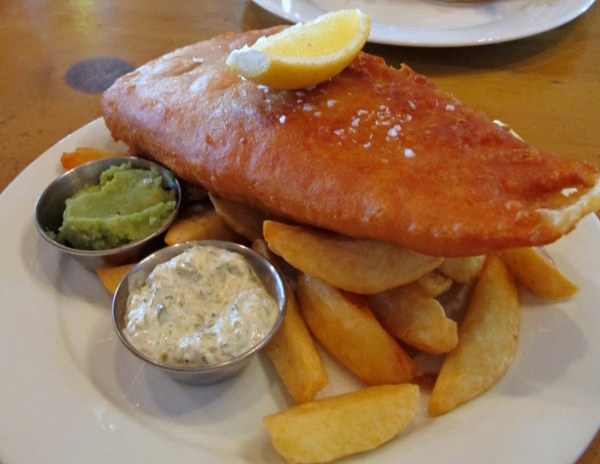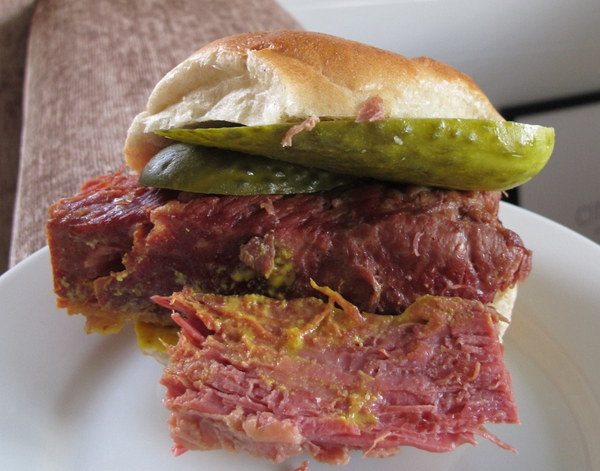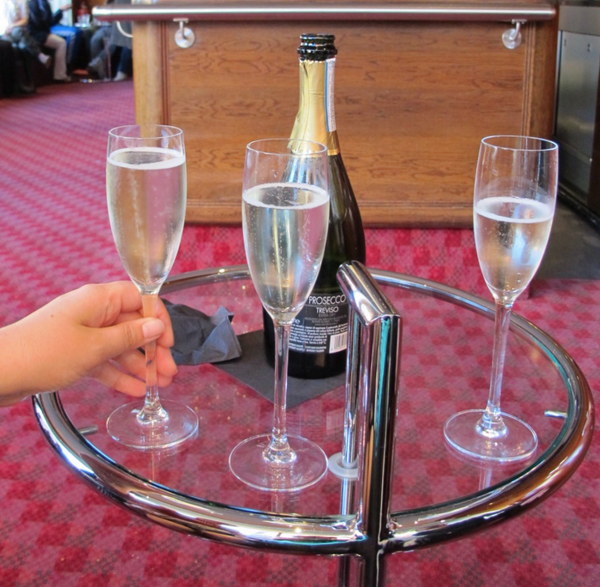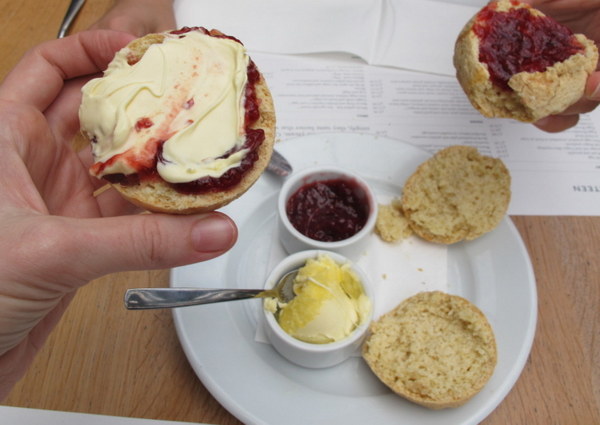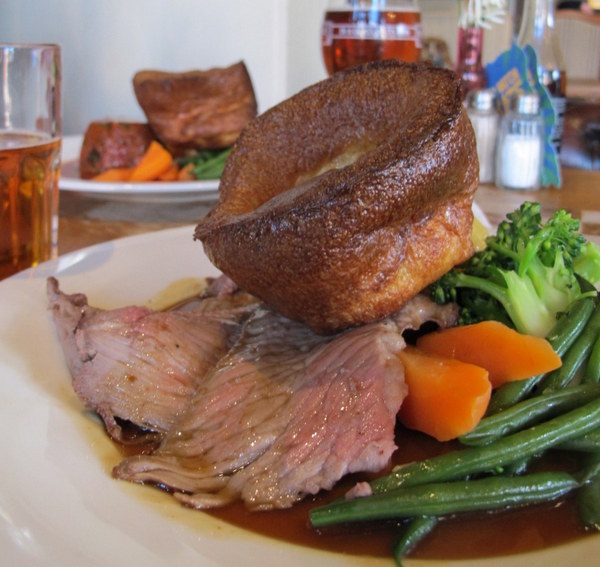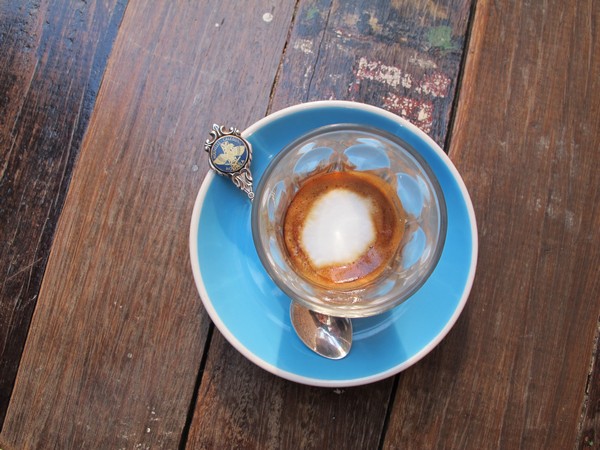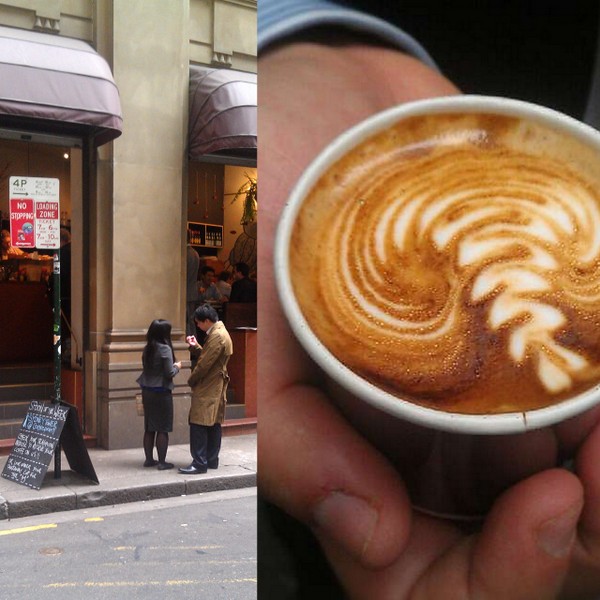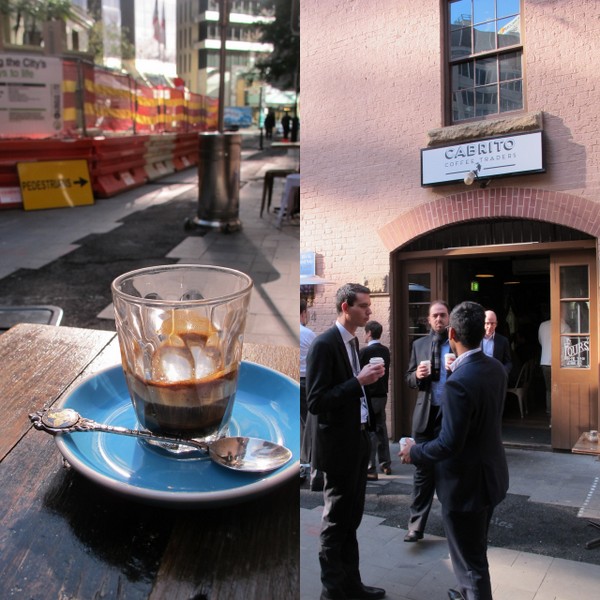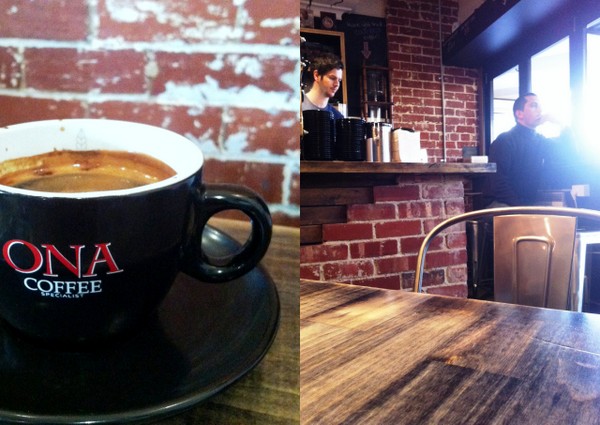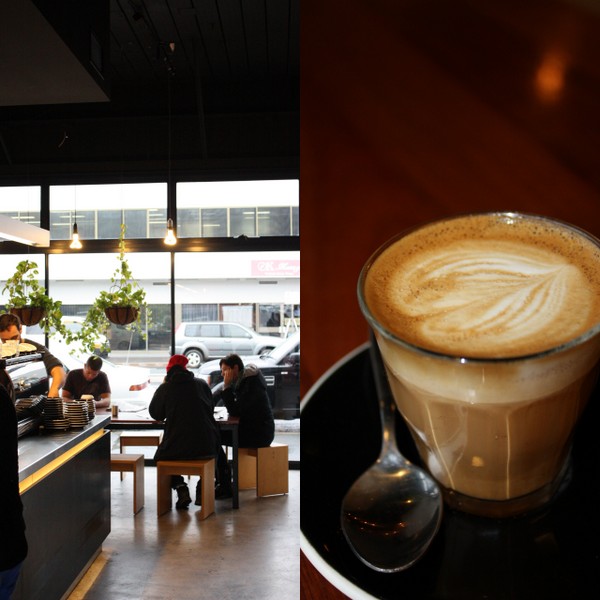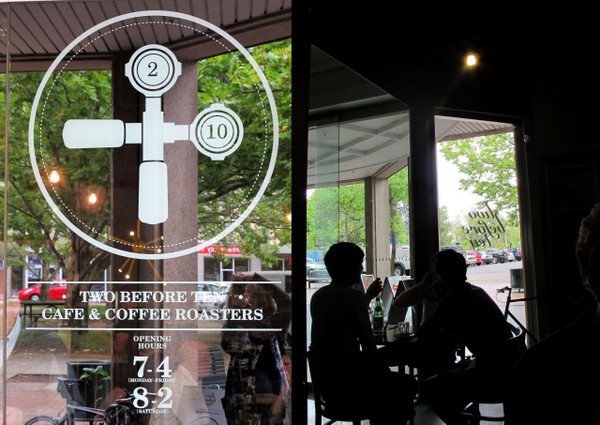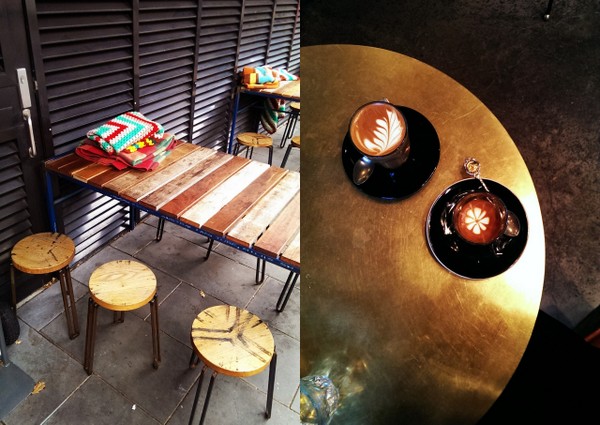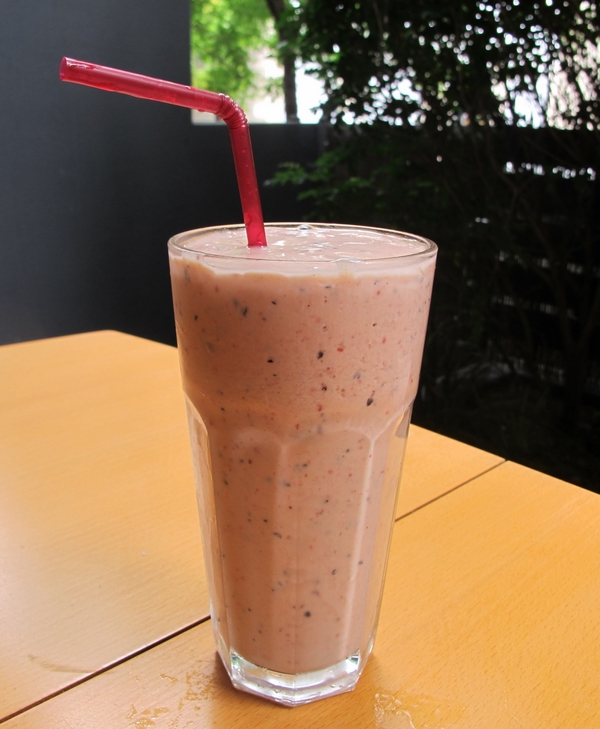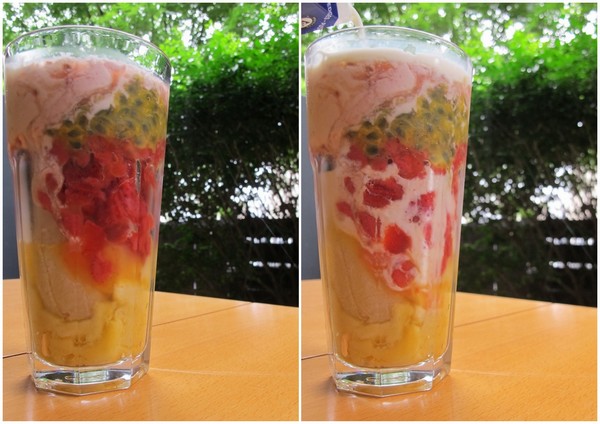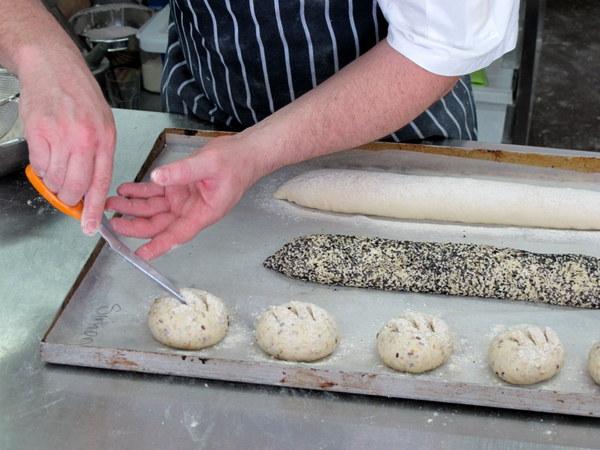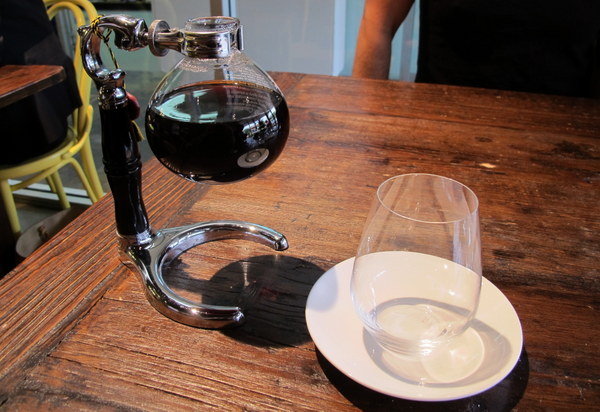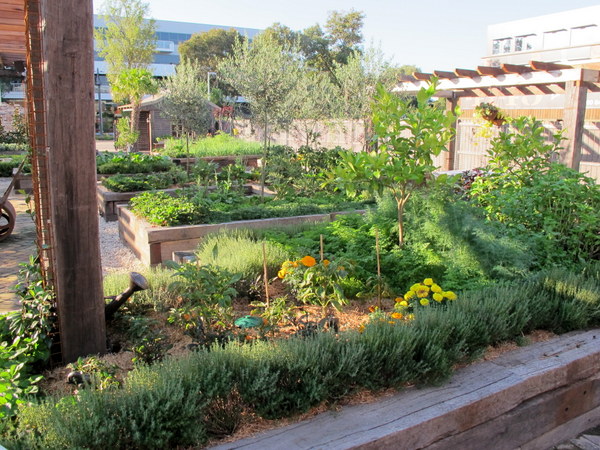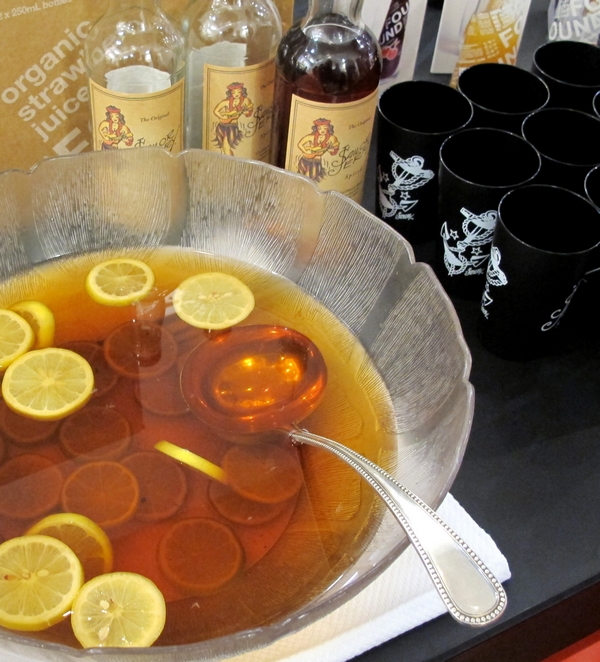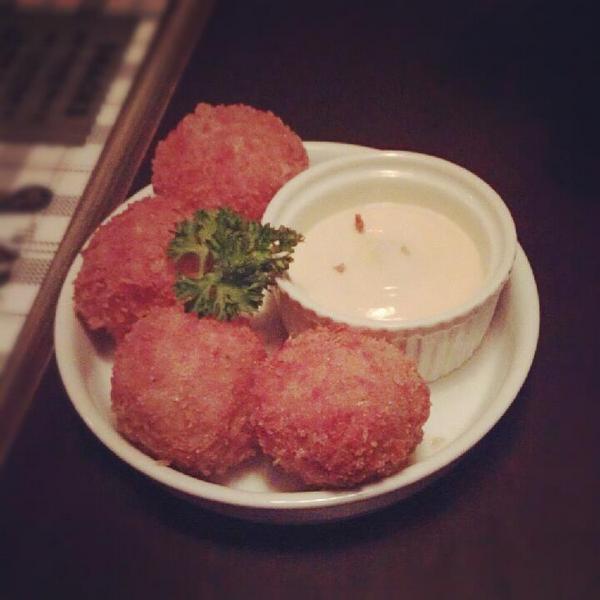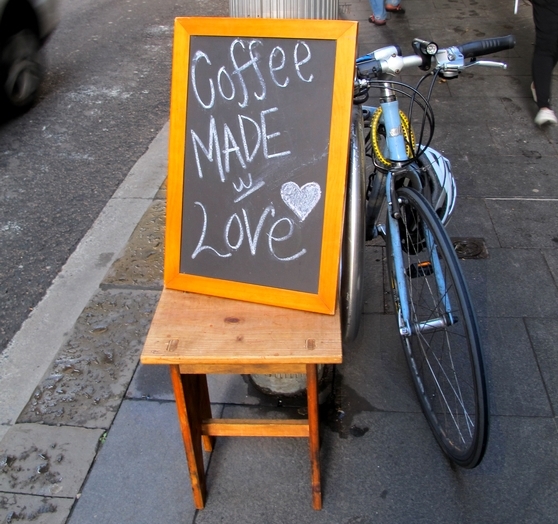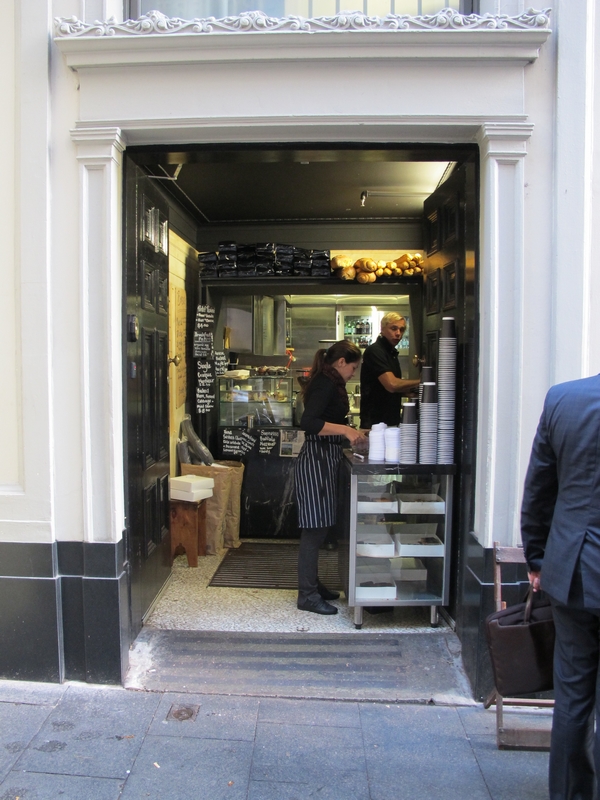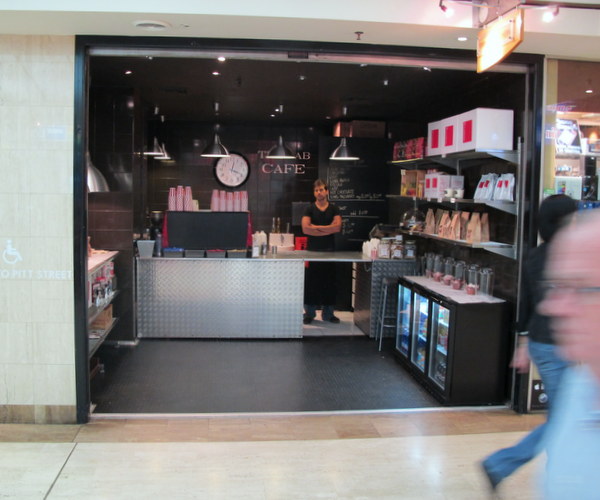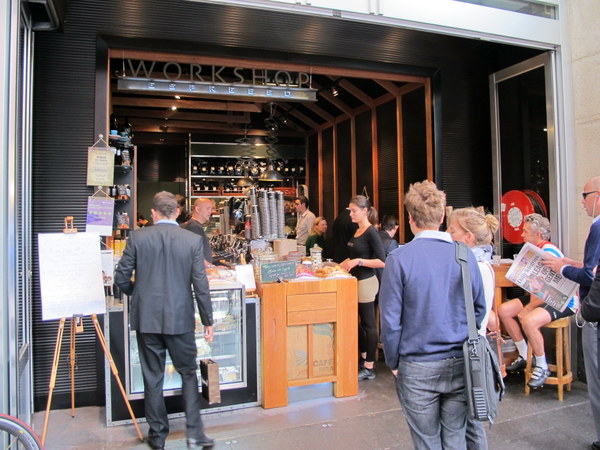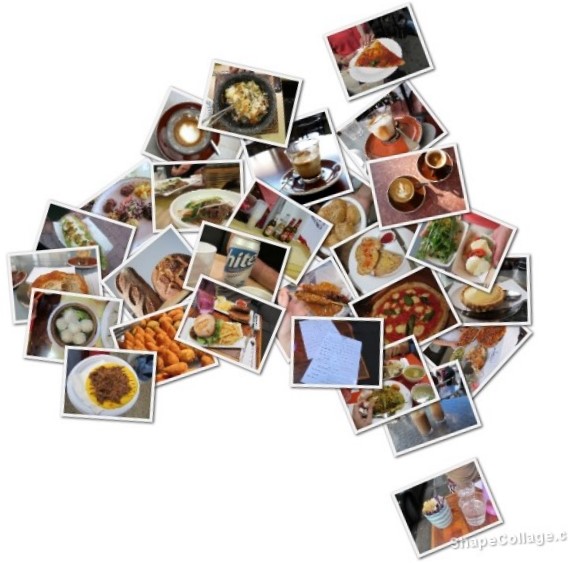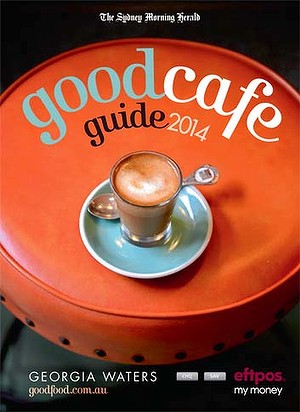1. Fish and Chips
I ordered fish and chips at a random pub (The Draft House Westbridge, to be exact) in Battersea and was not disappointed. A large plate was soon placed in front of me holding a generous portion of hake coated with a crisp, golden batter. This was balanced on a heap of hand-cut chips with sides of tartar and mushy peas and a juicy wedge of lemon. As I bit into the hake, the outer coating literally shattered and the flesh of the fish melted in my mouth. Worth. Every. Calorie.
2. Beigels with pickles and anything else
We tried them with bacon. We tried them with chive cream cheese. We tried them with the famed ‘salt beef’. But whatever these chewy beigels (pronounced ‘bee-guhls’) from Beigel shop were slathered with, a pickle (or as the Brits say, gherkin) was a must. In fact, I’d be tempted to go a gherkin-only beigel next time around. The tart, sweet firmness is all you need to offset the bouncy, starchy goodness of a real bagel.
3. Prosecco everywhere!
I’m counting all liquids other than water as ‘foods’ for the purpose of this post. I’ve been a fan of this Italian sparkling wine (apparently soon to go the way of champagne and port in terms of naming rights) since it was first deemed an acceptable breakfast drink. There didn’t seem to be a bar or restaurant we stumbled into during our two weeks in London that didn’t serve Prosecco, and it was the perfect summer (if you can call it that) arvo drink for when you just can’t face another room-temp British ale or lager. Not that I don’t like the aforementioned tipples, but they can be a meal unto themselves, and then you don’t have room for scones.
4. ‘Proper scones’
I was hell-bent on having high tea but in the end, Vegetaraian and I settled on scones for lunch one day at Canteen, Spitalfields market. I thought I knew scones. I did not know scones. I find it difficult to describe the sublime texture of these beauties, so incredibly crunchy on the outside yet flaky and buttery within, all at once shortbread-like yet soft. Served with clotted cream and house-made strawberry jam, it is no exaggeration to say they had our waitress salivating. She told us that every order of scones is baked fresh. And all this from a franchise!
5. A Sunday Roast, complete with Yorskshire pudding
This was my last big feed in LDN- roast lamb with steamed veggies, potatoes roasted in duck fat (!), Yorkshire pudding and a liberal ladling of gravy. This meal was a hearty, textural delight from start to finish. The meat was juicy, the pud crunchy, the edges soggy where they met with the gravy, and the potatoes, those starchy dream ‘vegetables’, perfectly decadent. I stopped short (just) of licking my plate clean.
I’d love to know your fave London eats for my next visit! Let me know in the comments below…
When it comes to coffee, the Sydney CBD is a great place to grab-and-go. Following on from my list of 3 great hole-in-the-wall cafés, I thought I’d share a few places in the city where you can sit down and savour your caffeine hit, rather than slamming it down on the way to another of your high-flying business meetings. Here are three cafés that, in the midst of the rat race, are more than happy bring you your coffee in a ceramic cup.
1. Double Barrel Coffee Merchants
The Double Barrel crew take their coffee extremely seriously, sourcing beans from Melbourne’s Seven Seeds and Code Black and Byron’s Marvell Street Coffee Roasters, among others. They always have at least a blend and a single O on the go. For those of the black coffee persuasion, they batch brew filter coffee, but they’ll also happily do you a pourover or an aeropress to order at their not-quite-up-and-running filter bar. It’s not just coffee, either; these guys make everything from scratch, from the slow-cooked meat subs to the salted caramel tarts to the muffins. Sean and the team are happy to talk shop, so order and pay at the counter, pull up a seat and sip your brew and talk the ins and outs of coffee flavour profiles or play video games.
Double Barrel Coffee Merchants
33 York Street, Sydney NSW 2000
0413 683 949
Monday-Friday, 6:30am-5:00pm
2. Marlowe’s Way
Marlowe’s may be a teensy place but if you time your visit right, you can nab a seat in this alleyway gem. Coffees seem ridiculously good value (a macch was $2.50 at the time of writing) and staff are super friendly. Each week one of their vintage teaspoons is chosen as ‘the magic spoon’, and whoever gets that spoon with their have-in coffee receives their second coffee for free, just one more reason to take 5 and have a real coffee break and drink out of a real cup. Marlowe’s uses a custom blend by The Little Marrionette, ‘the Banksian blend’, a fitting name for a café in the financial district. There’s usually a rotating single origin on offer, as well as artisanal teas and a basic Italian-inspired menu.
Marlowe’s Way
Cnr Tank Stream Way And Bridge Lane, Sydney NSW 2000
0432 487 598
Monday-Friday, 7:00am-4:00pm
3. Cabrito Coffee Traders
A cosy cafe in the Circular Quay area is surprisingly hard to come by, but Cabrito, the Spanish/Portuguese word for ‘little goat’ or ‘kid’, fits the bill. The menu may be bare bones (nu-wave lamingtons, sandwiches, toast) but if you can get an inside seat in this cozy little establishment you’re in for attentive service and solid coffee. These guys are hoping to start roasting their own coffee in future (they’re in a heritage listed building) but for now its a custom-roasted 4 Rascals blend. Bonus: they’re open Saturdays, somewhat of a rarity in the Sydney CBD.
Cabrito Coffee Traders
10-14 Bulletin Place, Sydney NSW 2000
02 8065 8895
Monday-Friday, 7:00am-4:30pm
Saturday 8:00am-2:00pm
Where’s your fave sit-and-sip café?
My not-so-secret dirty secret is that I was born in Canberra. An unlikely place for a caffeine fiend to develop a love of coffee, maybe, but as a result I’m a frequest visitor, and often asked for a list of coffee recommendations. A friend recently asked me for said list, which I’ve been meaning to write for some time now, and I decided it would better to leave you in the learned hands of my mate and resident Canberra coffee espert, Barrister Barista, a regular contributor to The Canberran. You can also catch her bite-sized reviews on twitter. Here are her 5 picks for Canberra caffeine hits.
1. Lonsdale Street Roasters (and LSR 23)
Lonsdale Street Roasters is arguably where Canberra’s “hipster coffee scene” all started – own-roasted beans, central location, wood-oven toasted paninis, milk crates for chairs, a small and loyal following growing exponentially, and coffee like nothing you’ve ever tasted before in Canberra. Now, you’ll queue patiently in peak times, have your order spelled phonetically by fresh-from-Sydney ANU students, elbow your way into bench seats, and take for granted the sheer flavour of the cup in front of you. And only on Lonsdale Street can you visit two venues of the same name – if the weather’s fine and queues are prohibitively sized, you’ll find a more outdoor-focussed LSR doing the same thing up the street across from the shiny new apartment complex.
Lonsdale Street Roasters
3/7 Lonsdale Street, Braddon ACT 2612
Lonsdale Street Roasters 23
23 Lonsdale Street, Braddon ACT 2612
2. ONA Coffee
These guys are the pros, the ones who will sell you serious equipment for making coffee at home, the peeps who run, enter and win all of the local coffee awards for roasting and barista tech. You can try ONA Coffee in two locations, both southside. The most accessible ONA Coffee is at ‘The Lawns’ in Manuka, the snooty southside suburb you may visit if you’re on government business or meeting relatives. It’s busy in there, and only order food if you’re on a leisurely time schedule. The original ONA Coffeehouse is in Fyshwick, where you may visit if your business relates to furniture, DIY or porn. Less busy, equally excellent.
ONA Coffee House
68 Wollongong Street, Fyshwick ACT 2603
ONA Coffee Manuka
Shop 4, The Lawns, Manuka ACT 2609
3. Lava Espresso
Perhaps the prettiest flat whites in Canberra, in the far from prettiest suburbs (no offence, Phillip). If your business in Canberra relates to cars or requires Westfield, take a small easy-park detour into industrial chic. Lava is a must for black coffee drinkers – the filter coffee is excellent and you’ll often be given a choice of two exotic growing locations. (FYI I normally reply Idunnowhicheverisbetter?). It’s also nice to be a in place where it’s acknowledged on the menu that ‘coffee with milk’ requires different treatment to just ‘coffee’. Bagel-based foods are also well-priced and tasty!
Lava Espresso
1/38 Townshend St, Phillip, ACT 2606 and
54 Brierly St, Weston Creek ACT 2611
4. Two Before Ten
OK, so your business in Canberra requires you to stay overnight in the soulful (ahem) ‘Civic’, and you’re looking for somewhere to grab a cheeky 8am breakfast? Two Before Ten, requiring some navigational nouse, will deliver friendly service and tasty eats at breakfast and lunchtime. Get yourself to the ‘plaza’ type space between Marcus Clarke St and Moore St, not as far East as the Melbourne Building (northwest corner of London Circuit and Northbourne Ave), take a deep breath, and look for bikes. Worth a visit, especially as the Qantas mag will soon be telling you about a groundbreaking venue called ‘A Baker’, a New Acton work in progress by the same owners.
Two Before Ten
40 Marcus Clarke St, Canberra, ACT 2601
5. Močan and Green Grout
Speaking of the Qantas mag, this esoterically named project is a must-visit for foodie and/or interior architecture geeks. It’s the Canberra cafe with a fit-out so unique you’ll take photos and tell your Sydney friends that you discovered a really interesting little cafe in Canberra: a total hole in the wall, built entirely of woodchip and origami cranes. You’ll have small breakfast dishes that are actually about the right amount of calories for breakfast, and then, because you were expecting to gorge yourself, you’ll probably order a muffin to share afterwards. Your coffee won’t be memorable but it’ll be good.
Močan and Green Grout
19 Marcus Clarke Street, Canberra, ACT 2601
Barrister Barista is a regular contributor to The Canberran. You can also catch her bite-sized reviews on twitter.
Like many of you who are in the midst of summer right now, I haven’t been cooking much of late. However, I have been getting back into smoothies come breakky time, so I thought I’d share some tips on how to take a glass of blended fruit and milk to something close to perfection.
1. Make your smoothie mostly fruit
There are two reasons for this. Firstly, as someone who isn’t a big fan of fruit unless somebody else has cut it up for me and garnished it with lashings of whipped cream, this is a sure fire way to get a big serve of multiple fruits in one go, without losing out on fibre as you do when juicing. Secondly, because milk isn’t the main ingredient, those who are lactose sensitive/intolerant or like to avoid dairy won’t be missing out – you can sub in juice, soy milk, soy yogurt, almond or rice milk, even coconut milk, as long as you chill it first.
2. Fill the glass, not the beaker/blender/food processor
In the past, I was forever getting the quantities (or the ratio of ingredients) wrong when it came to smoothies. I’d whack a bunch of ingredients in the beaker for my stick blender, blend away like mad, topple the lot into my glass and find I’d made too much/not enough/it was too watery. These days, I just fill as many glasses with fruit as needed, top with yogurt or ice cream, and fill to the brim with milk. Pour the glass/es into the blender and viola! The perfect size.
3. Freeze your fruit
This will give you a thickshake or melted ice cream consistency, making the smoothie feel treat-like rather than medicinal. It also means you can save your fruit before it goes strange by chopping, portioning and freezing it ready for smoothies. Your smoothie will be cold, delicious, and so thick you could eat it with a spoon. In fact, if you pop it in the freezer for half an hour you could even serve it as dessert.
4. Use 4 fruits or less
In the smoothie pictured, I have fresh mango, half a frozen banana, frozen strawberry pieces and the pulp of two passionfruit. I’ve noticed keeping things to 4 fruits or less gives a cleaner taste. Also, one of the strongest flavours in the smoothie is banana, which makes sense because bananas are one of the sweetest fruits you can buy, so I never put in more than half a banana unless I want that to be the only flavour. The worst smoothies I’ve had don’t taste like anything in particular because there are so many kinds of fruit in there that no one flavour stands out. So whatever your fave fruit is, go heavy on that.
5. Use a straw
Ok, so this is just a personal preference of mine, but doesn’t life just feel that much more luxurious when you’re sipping your drink through a straw? I’m not saying you’ll feel like you’re on a northern Brazillian beach or anything, but a straw can’t hurt. Hell, why not chuck in a cocktail umbrella for good measure.
What’s your fave smoothie recipe?
Now it’s May, I think I’m safe to tell you what you already know – what’s hot in food from where I sit – smack bang in the middle of inner-city Sydney. There are zero surprises and as many predictions. Read on to find out what’s hot right now.
1. diy/dit
From brewing your own beer and cider to from-scratch sourdough to a beehive on the roof, to pickling, canning and preserving, diy (do it yourself) and dit (do it together) food sprung up post-GFC as part of a wider trend including knitting, gardening and squeezing all your soap remnants into one big ball (ok, maybe not so much).
It’s now cool to act like a Granny and no one will laugh at you for growing your own kale. It’s kinda like how we used to take the piss out of people who ate squid, or garlic, or other ‘weird’ foods in the 70s and 80s, and now you can’t walk into a pub without someone shoving a plate of calamari and aioli in your face. We’re all guerilla gardeners and apprentice artisan bakers these days, but even so, this trend has spawned a whole market of people who would quite like to pickle their own cumquats, but simply haven’t the time. This is why ‘homestyle cooking’ is everywhere in cafes right now. Call me crazy, but if I want ‘homestyle food’, I’ll go to…my house?
2. Every kind of non-espresso coffee (except instant)
Cold drip, siphon/syphon, filter/pourover, french press, stovetop – we’re still loving our fresh ground beans, but espresso just doesn’t have the novelty these other methods do. Add to this the fact that an espresso machine is a pretty pricey (and huge) piece of gear, and low-tech gadgetry becomes a lot more attractive.
People are tasting coffees the way they once tasted wines, and the less milk and sugar the better. It’s fashionable to want to taste the coffee all by its lonesome (well, with water) and all else is considered additive – sugar, milk, cut that shit out right now. We’re all about purity, simplicity
3. locavore-ism
Right now it is suddenly *so important* where your food comes from. Locavore is the organic of 5 years ago, with people growing truss tomatoes on their teensy apartment balconies. We hate Colesworths ‘cause of the pressure they put on food prices, farmers and the waste that results when less-than-picturesque produce is rejected (and yet Aldi is apparently fine?) so we’re jumping on the Farmer’s Market bandwagon like there’s no tomorrow. Which is fair enough, as food security is one of the single biggest issues we face; there may *be* no tomorrow if we don’t sort this shit the fuck *out*. Oh, and heirloom tomatoes. We like those.
4. cocktails and other concoctions
From the old fashioned to the walrus slime parfait (yes, I made that up), cocktails are hot, and the bars that serve them even more so. Signature drinks, mixologists, ‘freestyle’ bars with no menus- it’s all happening. Ok, so a Caipirinha will set you back 16 rather than 6 dollars, but it’s worth it to pretend you’re in Brasil, or Cuba, or an episode of Mad Men, or a Marylin Monroe film or… a really expensive bar. Wake up and smell the spiced rum.
5. ‘Americana’ is still going strong
Anywhere that does a half decent take on South American, Central American, Mexican, southern US or just plain junk food is the place to be seen instagramming on your iphone right now. Hotdogs and Ice cream sandwiches are everywhere, tacos are the word du jour, Brasilian, Peruvian and Argentinean food is more and more common. You can get Chicken and waffles at the Jazz City Diner and burger joints are still going strong. Food bloggers are baking up American candy-flavoured-treats like there’s no tomorrow. Dive bar food and deep fried everything is well and truly on the menu – from The Dip’s Deep fried birthday cake to The Norfolk’s deep fried pickles to the Abercrombie’s deep fried pizza, pubs and bars are dishing up what everyone in the rest of the world thinks Americans eat.
Anyway…you tell me. What’s hot right now in your books? And where can we get it?
Ideally, we’d always have the time- and space- for a relaxed sit-down coffee in the morning sun. But in the fast-paced Sydney CBD where space is at a premium, it’s just not always possible. Luckily, limitations often breed great ideas and with these three teensy espresso bars, there’s definitely no need to compromise on quality. Here, in no particular order, are my picks for the three best Sydney CBD hole-in-the-wall coffee spots.
1. Joe Black X, 70 King Street
Not to be confused with Joe Black, Joe Black X is housed in a teensy alcove, squished up against the new Louise Vuitton store. There’s only one seat so it’s takeaway only, with menus scrawled on cardboard signs and delicious Little Pudding cakes peeking out of the display fridge. When I order my macch the barista has me watch him pour it and say ‘when’. Always a good sign.
Bean: Their own blend, roasted by Toby’s estate.
Price: $3
Food: Sandwiches, cakes and breakky treats abound. These guys are very diy, poaching chicken and making meusli and yogurt onsite.
Joe Black X
70 King Street
Sydney, NSW 2000
2. The Lab Cafe, 109 Pitt Street
The Lab is situated at the Pitt Street end of the Hunter Connection. They now have five stores in total. Their cakes and muffins are housed in bell jars with a bunch bagged up to go. My friend (not as much of a caffeine head as I) wanted something sweet so grabbed a muffin, which she said was delicious. And the staff are friendly too.
Bean: Di Lorenzo.
Price: $3 for a small, $3.60 for a large.
Food: Muffins, friands and biscuits.
The Lab Cafe
9/109 Pitt Street
Sydney, NSW 2000
www.thelabcafe.com
0451 038 795
3. Workshop Espresso, 500 George Street
Workshop has been doing a roaring trade since it opened in 2009, and it’s easy to see why. There’s always a glut of people outside – I was there early one Thursday morning and all seats were taken, with 6 people waiting for takeaways ahead of me. But never fear, these guys are efficient, friendly and know their stuff. You can also purchase their signature blend to take home.
Bean: Workshop blend by Toby’s estate, a variety of single origins.
Price: My takeaway macch was $3
Food: Word on the street is they have great breakky and lunch selections – they use Sonoma bread, a lot of toast-based things, sambos and cakes.
Workshop Espresso
Shop RG01A, 500 George Street, (The Galleries Victoria)
Sydney, NSW 200
02 9264 8836
Do you have a favourite hole-in-the-wall coffe place?
About a month ago, we got talking about unsolicited PR emails, specifically, badly written, poorly targeted ones and how bloggers react to them. I asked for your take- your experience, what irks you, what you like, and what could improve this process for you. What follows are my 5 tips for PR companies when approaching bloggers.
1. Read the about page
Or any other page that might tell you whether the blogger will be remotely interested in what you’re pedalling. So many PR companies do not do this at all and it astounds me. There are many blogs that are ad free, don’t do sponsored posts or giveaways and state this clearly, sometimes multiple times. There is not point contacting someone with a policy like this, for example.
2. Read the blog!
Before you even think about firing off an email, spend some time looking at the kind of posts the blogger writes. Are there sponsored posts or product reviews? Do they write about an area related to your product? For example, I write a lot about coffee so I was offered a coffee machine to review. This was hardly a surprising thing for me to review. Look at the sidebars. Are there any ads? Do you think this is deliberate? Try and see where your promotion might be a good fit. If the answer is resounding ‘no’, let it lie.
3. Write a real email
You wouldn’t send the same cover letter out for every job, why would you send the same email to every blogger? You are pitching your product/promotion to the blogger, not he other way around. Don’t expect them to be grateful (although they may be) and don’t expect them to jump at the chance to run your promotion. Their blog is a project in which they are the writer, graphic designer, photographer, editor, account manager, etc etc. As such, may selective about the kind of promotions, if any, they run. They may also get tons of offers every day, so give them plenty of time to read and consider yours (no point emailing me about a promotion that needs to run next month, for example). And for god’s sake, get the blogger’s name, and the name of their blog, right. If I get one more PR email addressed to ‘Laura’, I’ll scream!
4. Write a concrete, concise proposal
In other words, be clear. What are you offering? Spell it out. Even minor league bloggers will get a few PR emails a month, and they are not likely to bother replying if they have no idea what’s on offer. Don’t write to a blogger asking for all their stats, especially without giving them a clear picture of what they’re signing up for. You know what your company’s policy is/what promotion you’re offering, put it in the very first email. It may be something like ‘we pay $20 for each text-based ad you run for a month for any blogs with 1000+ pageviews/month’ or ‘we would like you to review our new flavour of chocolate and can send you 1kg of chocolate as payment’.
Having this information, the blogger immediately knows whether or not your promotion will be a good fit for them. And having read their blog, you’ll know this too. There’s no point in writing ‘we offer text based ads to enhance your online profile and monetise your blog’. What in the hell does that even mean? How many emails will it take me to find out?
5. Be flexible
By approaching bloggers like a real person, you need to be prepared for a real answer. If there’s any scope at all for you to be flexible with your proposal, do so. Sometimes a blogger might have another way of looking at what you’re doing that may be of benefit. For example, you might offer to give them a free product, but they might prefer to give it away to their readers. You might ask for a review, they may prefer to use you product in a recipe.
Even with these tips in mind, you need to be prepared to be turned down. But hopefully you’ll get a reply, perhaps even one that’s speedy and polite, and you can cross that blog off your list.
What are your tips for PR reps when approaching bloggers?
Sydney
For your caffeine hit
Cafe Dov, Potts Point
Bang Bang Espresso, Surry Hills
Becasse Bakery, CBD
Bourke Street Bakery – All stores
Clipper Cafe, Glebe
Coffee Trails, Haymarket
Double Roasters, Marrickville
Gnome Espresso, Surry Hills
Petty Cash Cafe, Marrickville
Raw 101, Castle Hill
Reuben Hills, Surry Hills
Room 10, Potts Point
The Little Marrionette, Annandale
For a bite
Becasse, CBD
Charlie and Co, CBD
El Loco, Surry Hills
Gelato Messina, Darlinghurst
Jackie M, Concord (bookings required, txt 0424 260 494)
Ms G’s, Pott’s Point
Quarter 21, CBD
The Dip, CBD
Toko, Surry Hills
Rockpool Group Restaurants
For a drink
Coogee Bay Hotel, Coogee
Fredas, Chippendale
Wine Library, Woollahra
The Carrington Hotel, Surry Hills
Melbourne
For your caffeine hit
3 Bags Full Cafe, Abbotsford
Coin Laundry, Aramadale
Market Lane, Prahran Market
Monk Bohdi Dharma, Balaclava
Ora Cafe, Kew
Red Door Corner Store, Northcote
Yellow Bird Cafe, Prahran
For a bite
Ladro, Prahran
Rockpool Group Restaurants
Brisbane
Boardwalk Bar and Bistro, CBD
Grub Street Cafe, Gaythorne
The Fishery, Milton
Know somewhere else to eat/drink that’s open today? Comment below and I will add it to the list. Happy Australia Day, chums!
They let their food go cold. They rock fancy SLRs. They tweet up a storm, posting photos of their on-trend lunches and they always know where to get a good feed. Here are five facts about food bloggers you may not know.
1. They hate food fads just as much as you do
Macarons. Masterchef. Those over-blogged ‘it’ restaurants. Food bloggers have been there, done that, or at least read it in their mile-long blogroll. At EatDrinkBlog, one food blogger admitted to me, in hushed tones ‘I don’t think macarons are that great, actually.’ I had another prominent food blogger email me to agree that Sydney’s recent night noodle markets were both overrated and lacking in noodles. Chances are your fave food blogger is as sick of hearing about Jamie’s Italian as you are…or soon will be.
2. They’re zeitgeisty, not trendy
Food bloggers will break the next big thing months before the more cautious mainstream media. By taking risks, readers feel they get the inside scoop and other bloggers can follow suit and put in their 2 cents. As a rule, food bloggers don’t blog an experience they’re not that enamoured with, unless it’s macarons, possibly served at the night noodle markets by one of the contestants of masterchef, so the initial buzz bloggers create is often well-deserved.
3. They work extremely hard at what they do
Blogging requires consistent effort, especially for big name bloggers or those who have successfully monetised their blogs. Once readers regularly stop by or start paying for content, it becomes even more important to provide consistent, quality stuff. Food bloggers know they have to bring their readers something fresh and new that they can’t find on their own. A full-time blogger may work around 15 hours a day, 6-7 days per week. I myself spend about 8-10 hours a week just to produce 1-2 posts.
4. They’re often not as tech-savvy as you might think
Bloggers aren’t all tech heads, nor are they all graphic designers. When figuring out how to do something tricky on their blogs, the default method? ‘Google it’. I’m really glad I’m not alone in this, as along with visiting forums, it’s the method I usually use. Another thing I’ll do is to get in contact with bloggers who have a feature on their blog I particularly like, and ask them where they got it. Food bloggers are usually more than happy to share their knowledge and help you out.
5. They’re not all trying to get published in mainstream media
It’s often assumed by those outside the blogging community that bloggers are trying to get published in a ‘real’ medium. For some, this may be the case – they may be after freelance writing jobs or book deals. But for many, blogging can be a hobby, or it can be a business, it can be just plain fun. I know for myself the motivation is producing something, publishing something myself.
I don’t know about you, but I don’t plan on dying of some kind of vitamin or mineral deficiency in the next week. Sure, I could complete The $35 Challenge on nothing but mee goreng, oranges and beer, but that’s not really a sensible way to play it, and I’m nothing if not sensible. Below are my top ten tips for menu planning, your money and sanity saver. And not just during The $35 Challenge.
1. Take stock of your pantry
I just did and there is waaaaaaaaaaaay more stuff in there than I realized. 4 kinds of rice, three shapes of pasta, tins of tomatos, legumes, beetroot, pineapple, tahini, enough condiments and sauces to open a deli, at least 18 different spices and various baking ingredients – sugars, flours, cocoa, almond meal, rosewater, vanilla pods…the list goes on. Any and all of these things can form the starting point for a menu, so take a quick look in your cupboards.
2. Take stock of your fridge/freezer
Before I write a menu, I so often make the mistake of not checking what’s in the fridge or freezer. More condiments. A dozen eggs. Half a kilo of greek yogurt. Five kinds of cheese? All that’s really needed is a shitload of veggies and some meat and I should be able to sort out at least 5 main meals.
3. A menu is just a list
Here’s how you do it: write down every meal you’re going to eat. Then write down every ingredient you don’t already have which is in that meal. Then add anything else to your list that’s not technically part of a meal – snacks, fruit, cleaning products etc.
In fact, why not just write down everything you ate last week as a starting point? Maybe you eat all your lunches out and have toast for breakfast every day. In that case, a menu would just cover dinners. Maybe you order takeaway once a week? This doesn’t have to change, just pencil it in.Suddenly, your shopping list is done.
4. Plan regularly – about as often as you shop
I prefer to shop once a week, so I write a menu once a week. This is a trick I learned from my mum and it’s what has always worked for me. I find fortnightly shops mean I end up with stuff going off or getting forgotten about, and shopping every few days means I end up making a lot more impulse purchases. Find what works for you and stick to it.
5. Be realistic
This is key. You need to be realistic about what you’ll cook, how often you’ll cook and what you’ll actually eat. There are a few dishes that crop up again and again on my menus but never get made because they’re either too boring (chick pea stew anyone?) or too much effort come 6:00pm on a Thursday evening (yes, I will stuff and roast an entire chicken on a week night, without a recipe). Make it easy on yourself.
6. Consider what’s in season
Taste.com.au publishes a monthly list of all the fruit and veg in season. It’s often a good idea to have a look at something like this before you decide what to cook as it will give you some idea of what will be available, tasty and cheap.
7. Be flexible
Maybe you thought you’d serve grilled fish with mashed potato and green beans today – that’s what’s on your menu. But when you get to the supermarket, asparagus and pumpkin are on special, so you change your plans accordingly. Flexibility should also apply to when you want to serve something- just because your menu says taco Tuesday doesn’t mean you can’t switch it to Wednesday ‘cause your plans have changed. In my case, I don’t allocate specific days on my menu – my menu is just a list of meals in no particular order.
8. Throw in a few wildcards
Try and prepare one new dish a week or, failing that, try one new ingredient. Or, use an ingredient in a new way. This will stop your taste buds getting bored. Until recently I’d never really cooked steak or fish (I was vego for 10 years). A few weeks ago I finally tried pineapple as a savoury ingredient when I made this pineapple salsa. Try new things whenever there’s time or the mood takes you.
9. Stop asking yourself ‘what do I feel like eating today’?
If your menu is realistic, flexible and varied, you won’t need to ask yourself this question each day or for each new meal. By taking choice out of the equation on a case-by case basis, you’ve also taken out the work. Once menu planning is a habit, you’ll never look back.
10. Make your final weekly meal ‘odds ‘n ends’
Chances are no matter how meticulous your planning, you’re going to have a few things left at the end of the week. Maybe you didn’t make one of your meals or maybe you just ended up with too much of something. Either way, you can probably whip something up with what you’ve got. Then you’re all ready for your next menu.
It’s not too late to support the $35 Challenge. During Anti-Poverty Week, from October 16-22, participants have $5 a day to spend on food. By experiencing poverty for just 7 days, we come to a better understanding of the realities and stresses of those living in poverty. By blogging or tweeting this experience, we can raise awareness of an issue so often swept under the rug. And by donating the remainder of the money we would usually spend on food to OzHarvest, we can make a real difference.
About me
 Sharing easy recipes, hunting down the best coffee. Honest accounts, nothing too serious. Read more...
Sharing easy recipes, hunting down the best coffee. Honest accounts, nothing too serious. Read more...Recent Posts
- Aerpress means no more shit #travelcoffee and #workcoffee
- Why I write and four ace bloggers who do it better
- The five best things I ate in London
- Shoreditch is awesome, airports are not
- I quit sugar? Do I bollocks.
- Cubao Street Food, Alexandria
- The Reformatory Caffeine Lab, Surry Hills
- Brewtown Newtown
- Stay caffeinated over Christmas
- Gumption by Coffee Alchemy, Sydney CBD
Popular posts this month…
 Review – Philips Saeco Intelia posted on January 10, 2012
Review – Philips Saeco Intelia posted on January 10, 2012  Sparkling Long Black posted on May 10, 2011
Sparkling Long Black posted on May 10, 2011 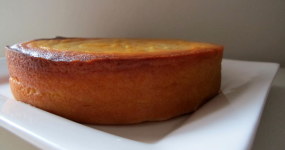 Kosher Whole Orange Cake posted on July 5, 2011
Kosher Whole Orange Cake posted on July 5, 2011  Vella Nero Coffee Couture, Sydney CBD posted on June 28, 2011
Vella Nero Coffee Couture, Sydney CBD posted on June 28, 2011 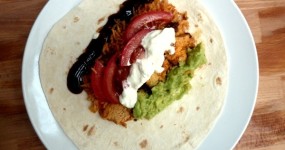 The quest for Mex part 2 – Feisty Chicken Burritos posted on December 21, 2010
The quest for Mex part 2 – Feisty Chicken Burritos posted on December 21, 2010 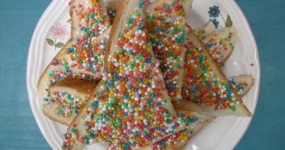 Fairy Bread posted on March 11, 2011
Fairy Bread posted on March 11, 2011 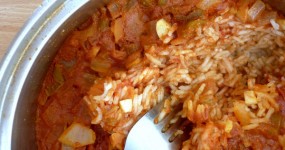 The quest for Mex part 1 – Mexican Red Rice posted on December 17, 2010
The quest for Mex part 1 – Mexican Red Rice posted on December 17, 2010  Café review – Flint and Steel (Coffee Alchemy), Marrickville posted on March 1, 2011
Café review – Flint and Steel (Coffee Alchemy), Marrickville posted on March 1, 2011
Disclaimer:
All opinions in this blog are mine, an everyday, real-life person. I do not accept payment for reviews and nor do I write sponsored posts. I do not endorse the content of the comments herein.

